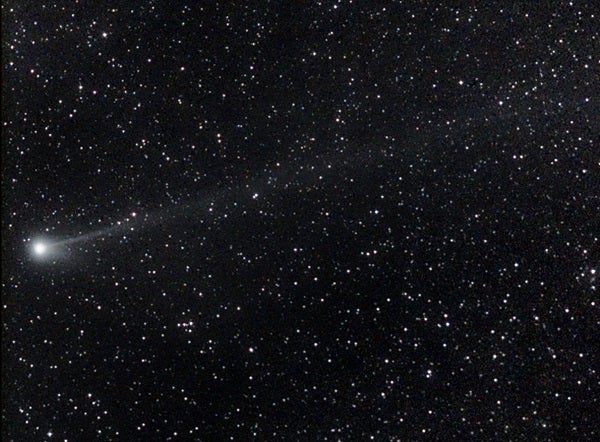Many of the most well-known comets, including Halley, Hale-Bopp, and, most recently, McNaught, may have been born in orbit around other stars, according to a new theory by an international team of astronomers led by a scientist from the Southwest Research Institute (SwRI) in Boulder, Colorado.
Hal Levison from SwRI; Martin Duncan from Queen’s University, Kingston, Canada; Ramon Brasser from Observatoire de la Cote d’Azur, France; and David Kaufmann from SwRI used computer simulations to show that the Sun may have captured small icy bodies from its sibling stars while it was in its birth star cluster, thereby creating a reservoir for observed comets.
While the Sun currently has no companion stars, it is believed to have formed in a cluster containing hundreds of closely packed stars that were embedded in a dense cloud of gas. During this time, each star formed a large number of small icy bodies — comets — in a disk from which planets formed. Most of these comets were gravitationally slung out of these prenatal planetary systems by the newly forming giant planets, becoming tiny free-floating members of the cluster.
The Sun’s cluster came to a violent end, however, when the hottest young stars blew out its gas. These new models show that the Sun then gravitationally captured a large cloud of comets as the cluster dispersed.
“When it was young, the Sun shared a lot of spit with its siblings, and we can see that stuff today,” said Levison.
“The process of capture is surprisingly efficient and leads to the exciting possibility that the cloud contains a potpourri that samples material from a large number of stellar siblings of the Sun,” said Duncan.
Evidence for the team’s scenario comes from the roughly spherical cloud of comets known as the Oort Cloud, which surrounds the Sun, extending halfway to the nearest star. It has been commonly assumed that this cloud formed from the Sun’s protoplanetary disk. However, because detailed models show that comets from the solar system produce a more anemic cloud than observed, another source is required.
“If we assume that the Sun’s observed protoplanetary disk can be used to estimate the indigenous population of the Oort Cloud, we can conclude that more than 90 percent of the observed Oort Cloud comets have an extrasolar origin,” said Levison.
“The formation of the Oort Cloud has been a mystery for over 60 years, and our work likely solves this long-standing problem,” said Brasser.










